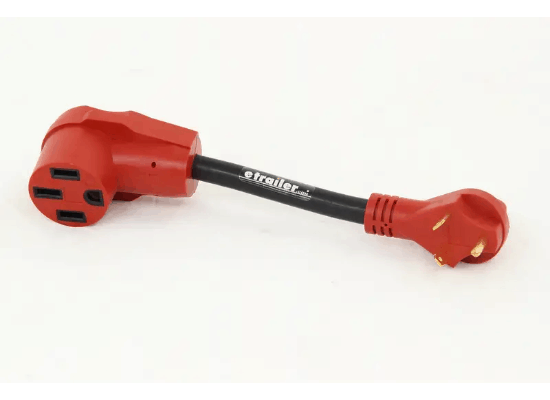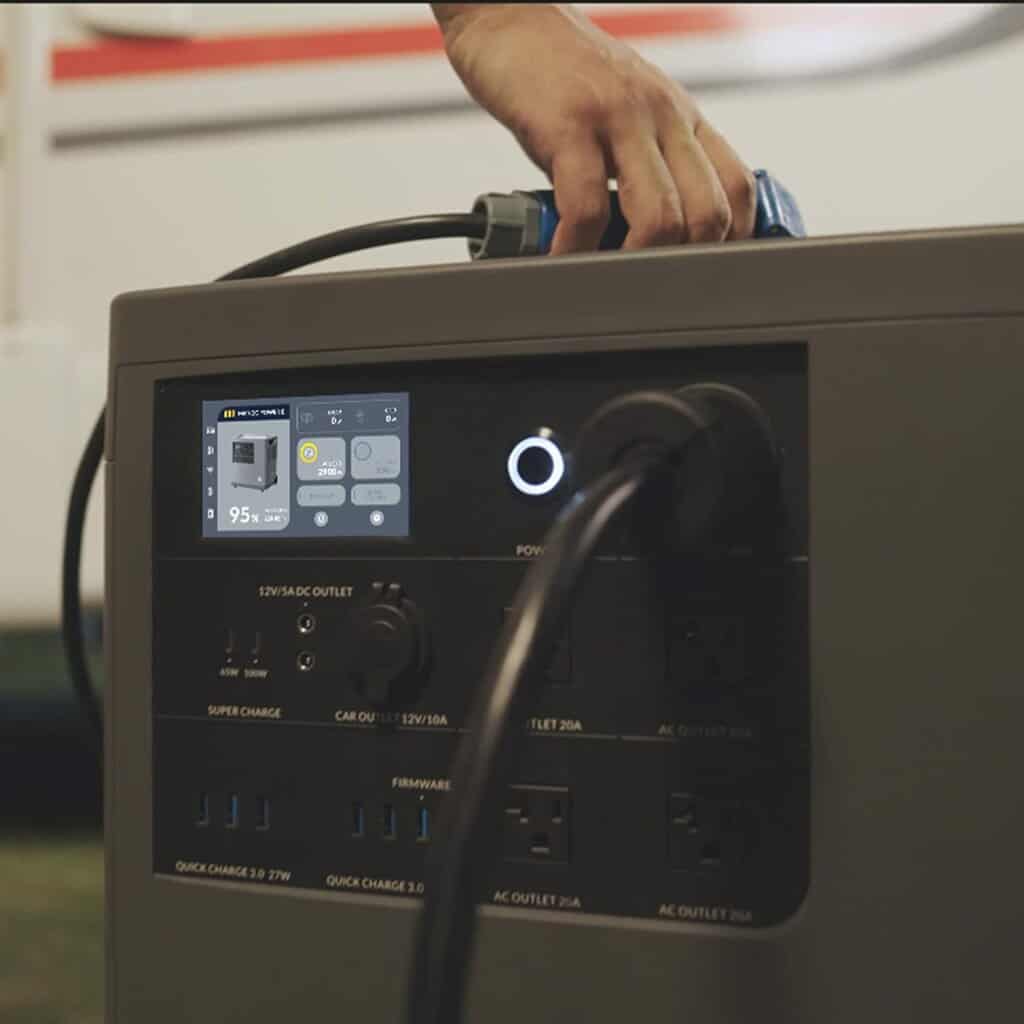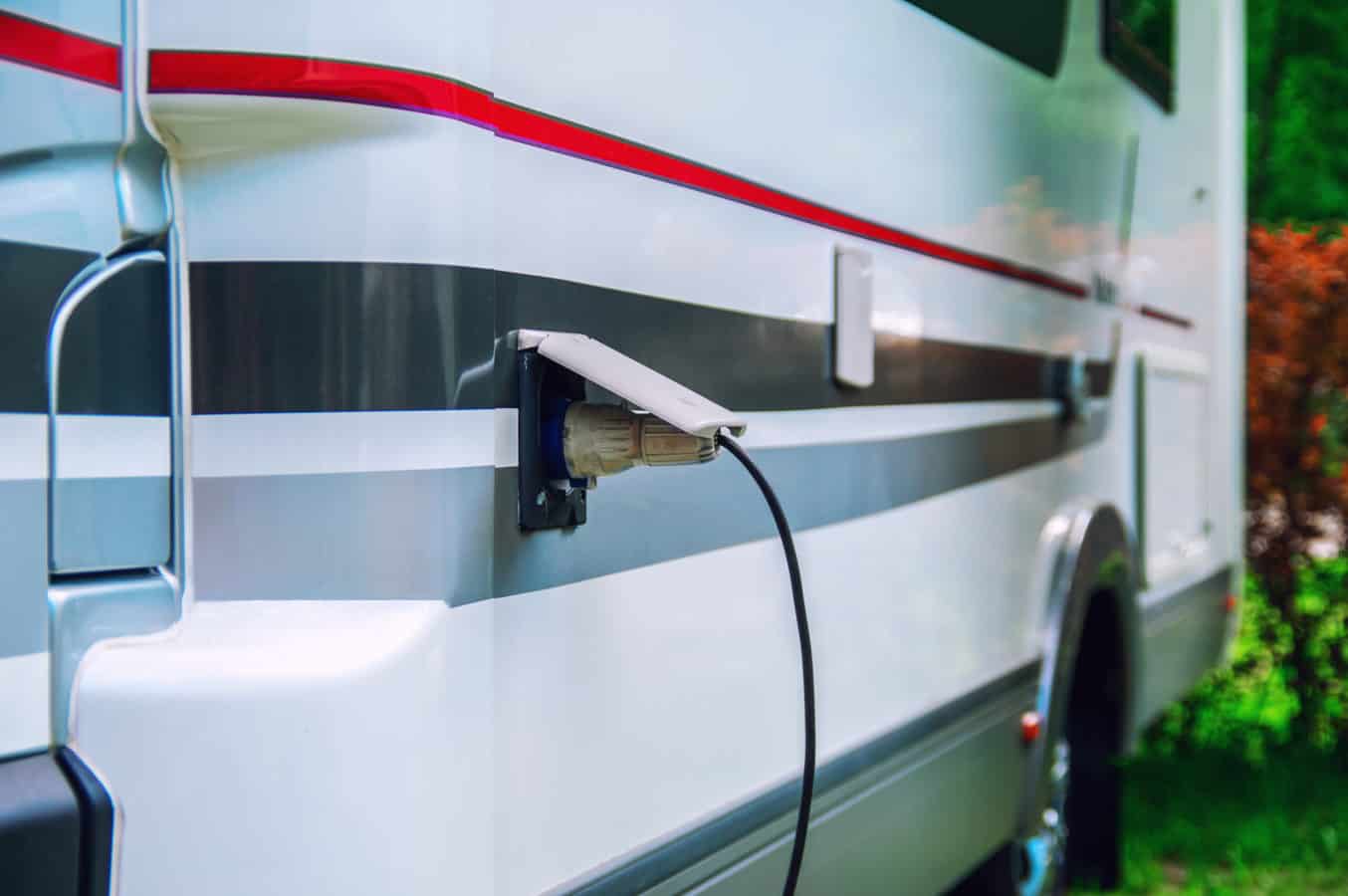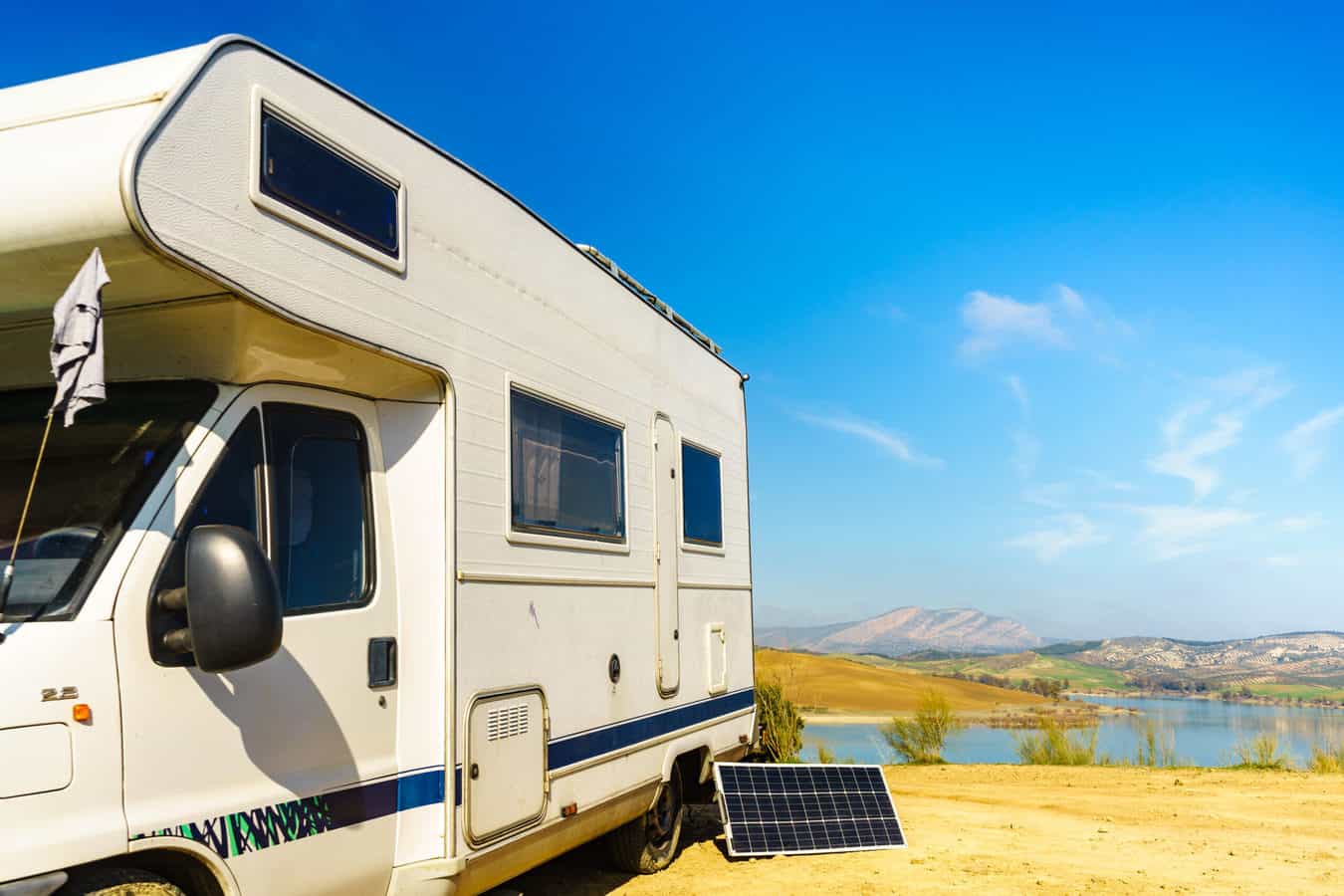
How To Run Your RV On 30 Amps
As more power-hungry appliances and devices have been added to RVs over the years, rigs that use a 50 amp RV plug have become more common. Unfortunately, many RV parks around the country were wired when 30 amp was the norm and have not yet overhauled their entire parks system to have both 50 and 30 amp plugs.
Considering 30 amp sockets are more common, if you plug your RV rated for 50 amps into a 30 amp socket, can you run it? The answer is yes, but it’s complicated. Before answering any electrical question, it is important to understand a little about how electricity works, and more importantly, how a 30 amp and 50 amp RV plug works.
RV electrical basics
Many people hear the word electricity and think it is an incredibly difficult science with tons of equations. They would prefer to think of electricity as the magic flowing through the walls that makes their stuff work. They are right on both of those thoughts.
Electrical engineers go through a lot of schooling and are required to know many formulas, laws, principles, and history. They must understand the nitty-gritty details of how exactly one gets the electrons in a wire to flow one direction or another and how to make them flow in the manner they want.
Fortunately, RVers aren’t required to understand how exactly electricity works or how it even gets from a power plant to the power post. That part can continue to be magic. RVers just need to know how to use it. For example, you may not know how a TV produces a picture on a screen, but you know how to turn it on and channel surf.
As an RVer, all you need to know is electricity is available at a power post, it flows through wires with a pressure measured in volts, and it comes in three speeds: 15/20 amp, 30 amp, and 50 amp.
What are volts and amps?
An amp is a measure of current. Think of electricity like water in a hose. Let’s say we turned the hose on, and it had a spray nozzle at the end of it. The hose would fill up with water, and the hose would be pressurized. We measure that water pressure in pounds per square inch, or PSI if we are using the imperial system.
For the sake of argument, there is 120 psi of pressure now in the hose. No water is flowing, but the moment the handle on the nozzle is pressed, water will have a direction to flow and it will be pushed out of the hose at 120 psi.
Electricity works kind of like the water and the hose. We don’t measure it in psi, though, because it isn’t water. It works similar to the water in how it moves through the wire but without exerting physical pressure as we have experienced with plumbing. Rather than physical pressure, we call this magic electrical pressure VOLTS.
Just like the hose, think of the electrical lines of your RV as being “pressurized” with about 120 volts of pressure. When you plug something in and turn it on, the electricity will be pushed into the electrical device at approximately 120 volts. I say approximately because that depends on the park’s wiring and some other factors, but more on that later.
The water in the hose would be moving at a particular speed as it flowed through the hose. We like to measure water with gallons, so we could calculate the amount of water using gallons per minute or gallons per hour. Regardless of the time unit, we are able to get an idea of how fast the water is flowing through the hose. For electricity, we measure this current in AMPS.
Watts are a unit of power
An electrical device needs a constant supply of a certain amount of power to continue to run. This is measured in WATTS.
To get the watts that it needs to run, there have to be enough volts (pressure), pushing the electricity with enough amps (speed) to get the amount of power (watts) continually into the device.
30 amp vs 50 amp
Using the hose analogy, 120 psi can flow through a hose that is 1 inch in diameter much faster than a hose that is half an inch in diameter. In the case of electrical lines, a 50 amp RV plug will deliver power (watts) much faster than a 30 amp RV plug.
When you plug a 50 amp RV plug into a 30-amp socket using an adapter, you are limiting yourself to a maximum speed of 30 amps. What do you think would happen if we hooked the water hose up to several devices that needed a total of 40 gallons of water per minute to work, but the diameter of the hose could only push 30 gallons per minute? The hose would fail, or the devices would fail, perhaps both. It may even cause damage to one or the other.
Moving back to electricity, plugging into a 30 amp socket is not necessarily a question of can you run it, but how many things you run at the same time.
Figuring out how many amps you are running
watts / volts = amps
It is said that electrical plugs in North America are 120 volts. That is an approximation. In reality, depending on several factors, RV parks can vary by 5-10 volts and sometimes more.
It is handy to have a voltmeter plugged in to one of the sockets in your RV, so you know what the park is putting out. Amperage discussion aside, the park should be putting out at least 109 volts. Any lower and the risk of damaging things like A/C compressors becomes high. On average though, 115 volts are about where most places should sit.
So with the equation above, if I had a 1000 watt microwave running, the equation would look like this:
1000 watts / 120 volts (Or what your voltmeter says) = 8.3 amps
Knowing the voltage being put out by the campground is important because it directly affects the amperage required to run an appliance. For example, let’s substitute the volts in the equation above with 110.
1000 watts / 110 volts = 9 amps
The difference isn’t much, but in some cases, it is the difference between an appliance running and a tripped breaker.
You can go around to each appliance you have and convert its wattage to approximate amperage. Put a piece of tape on that appliance with that number and add up the amps of running devices. The main purpose of giving the formula above was to give an idea of how an appliance’s wattage translates into amps being used.
Another method is to add up all the watts being used and know how many watts are available. You can figure that out by using the following equation:
amps * volts = watts
30 amps * 120 volts = 3600 max watts can be used.
Here is the dirty little secret about 50 amp RV plugs. They aren’t exactly 50 amps. At the power post, they are wired for 240 volts and split into two 50 amp breakers. That is why, when you look at a 50 amp plug, it has four prongs compared to three on a 30 amp plug. The extra prong carries the second 120 volt connection to get 240 volts total. The 50 amp RV plug runs the 240 volts to its breaker box, where it is split into two 120 volt systems. This means the RV can actually accommodate 12,000 watts.
50 amps * 240 volts = 12000 watts
Now let’s take a look at some common appliances and see what kind of wattage they require. We can compare that to a 30 amp system’s abilities and figure out if it can run it. Keep in mind that most household sockets in an RV are only wired to handle 15 amps. It is never a good idea to load up one socket inside your RV with more than 1800 watts at 120 volts.
| Appliance | Load Range (Watts) | Average Load (Watts) |
|---|---|---|
| Air Conditioner (each) | 1400-2000 | 1700 |
| Battery Charger | Up to 2,000 | 1000 |
| DC Convertor | 300-1200 | 750 |
| Refrigerator | 600-1000 | 800 |
| Microwave Oven | 1000-1500 | 1250 |
| Electric Frying Pan/Wok | 1000-1500 | 1250 |
| Electric Stove Element | 530-1500 | 675 |
| Electric Water Heater (6 gallon) | 1000-1500 | 1250 |
| Electric Iron | 500-1200 | 850 |
| Hair Dryer | 500-1500 | 1000 |
| Electric Coffee Pot | 550-750 | 650 |
| Television (CRT) | 200-600 | 400 |
| Radio | 50-200 | 125 |
| Electric Drill | 250-750 | 500 |
| Electric Broom | 200-500 | 350 |
| Electric Blanket | 50-200 | 125 |
| Portable Heater (Ceramic) | 1500-750 | 1500 |
| Toaster | 1200 | 1200 |
| Food Processor | 720 | 720 |
| Hand Vacuum | 240 | 240 |
| Crock Pot | 230 | 230 |
| Satellite Dish and Receiver | 200 | 200 |
| Heating Pad | 60 | 60 |
Keeping in mind that a 30 amp plug has approximately 3,600 watts available to play with, it looks like there is enough power to run one A/C unit, refrigerator, and an electric water heater at once.
You may be able to squeeze some more on there before a breaker pops, but that is pushing it. We haven’t accounted for the converter charger and other powered objects that may always be on.
Looking closer at the list, you may start wondering how you can work, cook, entertain, and keep cool on 30 amps. In short, it requires a little prioritizing.
For example, many refrigerators will run on either propane or electricity. Switching the refrigerator to propane will cut down on the wattage it uses. The same goes for electric water heaters. It does save propane to use them, but if you are having a summer cookout and want to keep your RV cool at the same time, something has to give when plugged into 30 amps.
It is a good idea to also write the wattage of all of your appliances and keep track of how many large wattage items are running at once. Don’t forget to include the A/C or any electric heating you may have. Even small space heaters can be 1500 watts when running on high.
How to run an RV on 30 amps
Now that you are well acquainted with how to track your wattage usage, it’s time to talk about some ways to make using 30 amps easier.
The first thing needed to use a 50 amp RV plug in a 30 amp socket is an adapter. These special plugs are often referred to as dogbones since the round plug shapes on either of the cord resemble a bone one might give to a dog.
If you have a 50 amp RV, you will want to get a dogbone that has a 50 amp female to 30 amp male. In other words, your 50 amp RV plug will fit into the female end and the 30 amp male side will plug into the power post of the RV park.

Remember that you only have 3,600 available watts to use. It is important to keep at least a mental tally of what is running. This may mean that if you are working on your laptop with the A/C on, you shouldn’t be running your electric water heater or washer/dryer at the same time.
It may be a good idea to run any appliances on propane that you can. This will free up watts for use when you are cooking, entertaining, or other activities you enjoy while RV camping.
Air conditioners and 30 amps
You may have noticed from the table above that A/C units are one of the worst offenders when it comes to watt usage. That’s only half the story.
When an A/C unit first starts up, it pulls a large amount of power. You will notice in the table above, the larger A/C units can use about 2000 watts. That number is true only when it is up and running. The same A/C unit will most likely draw 3500 watts or more when the unit first turns on.
Again, referring to the chart above, if you have basically anything else running at the time your A/C unit kicks on, you are likely overtaxing the 30 amp system. At best, the risk of tripping the park’s breaker is possible. Worst case, every time the A/C motor struggles to get enough power to start, it shortens the life of the unit.
Get a SoftStartRV unit
Installing a SoftStartRV device on your A/C unit is a good way to have your cake and eat it too when it comes to running a 50 amp RV off of a 30 amp socket.
A SoftStartRV unit is a unit that safely and gradually smoothes out the power spike that happens when you start up the A/C unit. It can reduce the startup amps by up to 70%.
In other words, it’s possible that an A/C unit that uses 1500 watts of power once running, will probably not go over that 1500 watts during startup.

By using a SoftStartRV unit, you don’t have to turn off your A/C every time you want to make coffee. Also, if you have multiple A/C units, installing SoftStartRV devices on each, may allow you to run both A/C units on a 30-amp connection when normally it is difficult to just run one A/C.
The other neat thing about the SoftStartRV is that it’s perfect for a do it yourself project.
“The install is actually quite easy. With just 5 wires and some easy install steps to follow, you’re done in no time.”
According to the SoftStartUSA website
There are some other advantages to installing a SoftStartRV. You may notice that your A/C makes a loud thump noise when it starts up. For some, it can be loud enough to wake them up. With the device installed, the A/C starts up much quieter, resulting in less interrupted sleep.
Can you run it?
So when it comes to plugging your 50 amp RV plug into a 30 amp socket, you can run it! Just make sure you are keeping an eye on how many watts or amps you are using.
Don’t try to use over 3600 watts or 30 amps while plugged into the 30-amp socket. If you like to keep cool and plan on using a smaller generator, or you’re camping where 30 amp is all that is available, a SoftStartRV device is a must.
Read more about RV electrical tips in this RV LIFE article: How Long Will My Batteries Last In Amp-Hours?
This post may contain Amazon affiliate links that may lead to referral compensation at no cost to you





You have somehow left out the fact that many RV parks have smaller circuit breakers than 30 or 50.
Many (yes, many RV parks have it posted that their “30A” service is only 25A and their so-called “50A” service is really just 40A. We’ve actually seen this crazy limitation on the 30A service much more often than on the 50A service.
Yes, it really is 50A per line. It is not a SECRET or a MYSTERY.
Hi Thanks for this.
I’m putting a new breaker for my 50 amp DX3 at my house. Can I assume that I would be using a 50-amp 2-pole breaker? It would seam that I would want to use 2-50 amp single pole breakers since the rig runs on 120 volt not 240 or am I suppose to feed the rig with 240 volt and the inverter/electrical panel knows what to do.
Thanks for any help
Check with an electrician. If there is a shared neutral it must be on a double pole breaker.
A 30amp supply is one line supplying 120V at 30amps (30X120=3600). A 50amp supply consist of two 120V lines at 50amps (120X50=6000). Two times 6000 is 12,000 watts. There is a significant difference between power supplied by a 30amp single line (phase) and 50amp dual line (two phase). Imagine the difference in power used by your 120V hair dryer and your 240V kitchen stove. In your RV one AC unit is generally powered by one of the 120V lines and the second one by the second 120V line. It is possible to damage the electrical system in your RV by connecting it to an incorrectly configured input power.
Easy to understand for an RV newbie like me. Thanks for sharing!
Lovely. I just shelled out $105K for a Class C and think I’ll be struggling in power mgmt. Not something I envisioned on such a cost. Nonetheless, thanks for this. Saving this page and will put your tips to use!
Excellent article! We are newbies and need the book “Camping for Dummies “!
Our GD Reflection runs on 50 amps and our first state park trip is on a 30 amp system. So glad to know we can run our fridge and hot water fridge on propane and still have air! Now just have to figure out how to turn on the propane to run them. Pray for us😩
So if you use a dog bone and you are using half of the 12000 watts on 50 amps does that mean with the dog one you can have 6000 watts on the 30 amp plug instead of 3600
Your calculations seem to be off. First, the 240 split is at the power pole, thus the two hot leads in the four prong power cord. Each hot lead is 120. You actually have 50 amps at 120 which is 6000 watts of power. That is why most generators in RV’s are in the 6000 to 7000 watt range.
Since there are 2 hot leads, does that mean at 120V and 50A each they will each be capable of 6000W? Or are they actually 25A each?
They are 50 amps each.
That is 6000 watts per Leg. You are using 2 legs of the 3 phase system.
Which equals 6000×2 = 12,000 watts.
You are using two (2) 120v legs.
If you measure between the legs with a volt meter, you will get 240 volts.
Or, 120v each leg to neutral .
I have an ONAN QG 5500. It has a double pole 25 amp breaker. Quick math says 25 * 120 * 2 = 6000w. So if I’m on generator, the best I can get is 2750 on the a circuit and 2750 on the b circuit. Keep in mind the circuit breaker is a safety mechanism. It’s wired to support the draw of the wire size. I can only get the full 50amp x2 when I’m on shore power.
Yes and that’s because the genny has only a single phase output that is Jumper’d inside to 2 circuit breakers and not a split phase output like shore power.
Thank you so much for this article and explanation.
We are purchasing a 50 amp 5th wheel after having a 30 amp Class C. The site we use in the summer is a 30 amp service so we will definitely need the adapter. Can we still use our 30 amp surge protector and plug the adapter in to it??
Enjoyed your article on how to run an RV on 30 A versus 50, just bought a motorhome and so I’m getting to learn the ropes, been trucking for years so mechanical problems are not an issue but electricity would be my biggest challenge, thanks again
Isn’t the 240 actually split at the power pole and two 120 lines run through the power cable to the RV breaker box? That is why there are four wires in the cord. Also, the 30/50 dog bone only has three wires.
Yes and it is called a split phase output and not part of a 3 phase power that as has been mentioned.
Here’s a new one for you…during a 3 day visit last summer at the RV-only campground inside the Grand Canyon south rim, all the 30 amp recepticals were inoperative, only the 50 amp service was available. Fortunately they had a number of 50-to-30 amp dog leg converters available to loan out to us 30 ampers. I considered buying one to add to my electrical kit, but decided I won’t encounter that scenario again anytime soon!
very good
Well explain for an electrical nul like me with a 30 amp RV. Thank you vm for the explanation. .l’ll make a copy of this for sure
Thank you very much for all the information you provided. It is very useful to a slightly new rv user.
Really enjoyed your article. Makes it very easy to understand and monitor power usage.
What does a $15 Hard Start kit not due that a $300 soft start kit does.
Good question and thanks for reading.
From SoftStartRV’s FAQ page:
13.Q. Why is SoftStartRV™ better than a “hard start kit”?
A. A hard start kit is simply a start capacitor and a thermal device that temporarily connects it to the compressor only for a short time during startup (a “PTCR”). During startup, the hard start diverts more current to the compressor’s start winding to help “boost” the torque to assist in starting. This actually results in more current be sent to the compressor, perhaps for a slightly shortened duration of time. A hard start therefore typically does not make a compressor that wouldn’t start on a particular generator suddenly start working, unless the generator and A/C combination were marginally close to working to begin with. That is why some do report success when using a hard start kit. In most cases though, these results are a marginal improvement at best, and are not always reliable, especially when the generator also has auxiliary loads before the compressor startup actually occurs. SoftStartRV™ on the other hand, is a sophisticated, controlled soft start device that dramatically reduces the total startup current drawn by the compressor. This has a direct impact and improvement on the generator’s capability to actually start up the compressor. No hard start kit comes close to doing any of this.